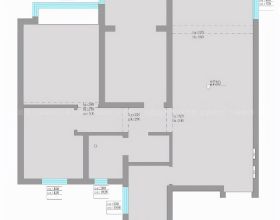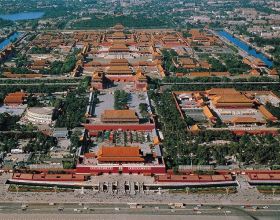Newly named human species may be the direct ancestor of modern humans
新命名的人類物種可能是現代人類的直接祖先
Scientists have named a new species that may have been the direct ancestor of modern humans.
科學家命名了一個新物種,它可能是現代人類的直接祖先。
The newly proposed species, Homo bodoensis — which lived more than half a million years ago in Africa — may help to untangle how human lineages moved and interacted across the globe.
這個新提出的物種,博多人——生活在50多萬年前的非洲——可能有助於解開人類譜系在全球範圍內是如何移動和相互作用的。
Although modern humans, Homo sapiens, are the only surviving human lineage, other human species once roamed Earth. For example, scientists recently discovered that the Indonesian island Flores was once home to the extinct species Homo floresiensis, often known as "the hobbit" for its miniature body.
雖然現代人類,智人,是唯一倖存的人類世系,其他人類物種也曾在地球上游蕩。例如,科學家最近發現印度尼西亞的弗洛雷斯島曾經是已經滅絕的弗洛瑞斯人(Homo floresiensis)的家園,這種人因體型極小而被稱為“霍位元人”(the hobbit)。
Deciding whether a set of ancient human fossils belongs to one species or another is often a challenging problem open to heated debate. For instance, some researchers suggest that skeletal differences between modern humans and Neanderthals mean they were different species. However, other scientists argue that because there is recent abundant genetic evidence that modern humans and Neanderthals once interbred and had fertile, viable offspring, Neanderthals should not be considered a single species.
確定一組古人類化石是否屬於一個物種,經常是一個充滿挑戰的問題,並引發激烈的辯論。例如,一些研究人員認為,現代人和尼安德特人之間的骨骼差異意味著他們是不同的物種。然而,其他科學家認為,由於最近有大量的基因證據表明,現代人類和尼安德特人曾經雜交,併產生了可繁殖的後代,尼安德特人不應該被視為一個單一的物種。
In the new study, researchers analyzed human fossils dating from about 774,000 to 129,000 years ago (once known as the Middle Pleistocene and now renamed the Chibanian). Previous work suggested modern humans arose during this time in Africa, while Neanderthals emerged in Eurasia. However, much about this key chapter in human evolution remains poorly understood — a problem paleoanthropologists call "the muddle in the middle."
在這項新的研究中,研究人員分析了距今約77.4萬至12.9萬年前的人類化石(曾被稱為中更新世,現在更名為Chibanian)。先前的研究表明,現代人在這段時間出現在非洲,而尼安德特人出現在歐亞大陸。然而,關於人類進化中的這一關鍵章節,人們仍然知之甚少——古人類學家稱之為“中間的混亂”。
Chibanian-era human fossils from Africa and Eurasia are often assigned to one of two species: Homo heidelbergensis or Homo rhodesiensis. However, both species often carried multiple, and often contradictory, definitions of the skeletal characteristics and other traits that described them.
來自非洲和歐亞大陸的chibanian時代的人類化石通常被歸為兩個物種之一:海德堡人(Homo heidbergensis)或羅德西亞人(Homo rhodesiensis)。然而,這兩個物種通常對骨骼特徵和其他描述它們的特徵有多種且經常相互矛盾的定義。
Recent DNA evidence has revealed that some fossils in Europe dubbed H. heidelbergensis were actually from early Neanderthals. As such, H. heidelbergensis was a redundant name in those cases, the scientists noted.
最近的DNA證據顯示,歐洲一些被稱為海德堡人的化石實際上來自早期尼安德特人。因此,科學家們指出,海德堡人在這些案例中是一個多餘的名字。
Similarly, recent analyses of many fossils in East Asia now suggest they should no longer be called H. heidelbergensis, the researchers added. For instance, many facial and other features seen in Chibanian East Asian human fossils differ from those seen in European and African fossils of the same age.
研究人員補充說,類似地,最近對東亞許多化石的分析表明,它們不再應該被稱為海德堡人。例如,在Chibanian東亞人類化石中發現的許多面部和其他特徵與在歐洲和非洲的同時期化石中發現的不同。
In addition, Chibanian fossils from Africa are sometimes called both H. heidelbergensis and H. rhodesiensis. The scientists also noted that H. rhodesiensis was a poorly defined label that was never widely accepted in science, due in part to its association with controversial English imperialist Cecil Rhodes.
此外,來自非洲的Chibanian化石有時也被稱為海德堡人和羅得西亞人。科學家們還指出,羅得西亞人是一個定義不明確的標籤,從來沒有被科學界廣泛接受,部分原因是它與有爭議的英國帝國主義者塞西爾·羅茲(Cecil Rhodes)有關。
To help deal with all this confusion, the researchers now propose the existence of a new species, H. bodoensis, named after a 600,000-year-old skull found in Bodo D'ar, Ethiopia, in 1976. This new name would encompass many fossils previously identified as either H. heidelbergensis or H. rhodesiensis. The researchers suggest that H. bodoensis was the direct ancestor of H. sapiens, together forming a different branch of the human family tree than the one that gave rise to the Neanderthals and the mysterious Denisovans, which Siberian and Tibetan fossils suggested they lived about the same time as their Neanderthal cousins.
為了解決這些困惑,研究人員現在提出了一種新物種的存在,即H. bodoensis,以1976年在衣索比亞的Bodo D'ar發現的一個60萬年前的頭骨命名。這個新名字將包括許多以前被認為是海德堡人或羅得西亞人的化石。研究人員認為,博多人是智人的直系祖先,他們共同形成了人類族譜的一個不同分支,而尼安德特人和神秘的丹尼索瓦人的祖先則來自西伯利亞和西藏的化石,表明他們生活在大約同一時期。
"Giving a new name to a species is always controversial," study co-lead author Mirjana Roksandic, a paleoanthropologist at the University of Winnipeg in Canada, told Live Science. "However, if people start using it, it will survive and live."
“給一個物種取一個新名字總是有爭議的,”研究的主要作者之一、加拿大溫尼伯大學(University of Winnipeg)的古人類學家米里亞娜·洛克桑迪奇(Mirjana Roksandic)告訴趣味科學網站(Live Science)。“然而,如果人們開始使用它,它就會生存下來。”
In this new classification, H. bodoensis will describe most Chibanian human fossils from Africa and the Eastern Mediterranean. Many Chibanian human fossils from Europe would get reclassified as Neanderthals. The names H. heidelbergensis and H. rhodesiensis would then disappear. Chibanian human fossils from East Asia may get their own names with more research.
在這個新的分類中,博多人將描述大多數來自非洲和地中海東部的Chibanian人類化石。許多來自歐洲的Chibanian人類化石將被重新歸類為尼安德特人。海德堡原蟲和羅得西亞原蟲這兩個名字隨後就消失了。隨著更多的研究,來自東亞的Chibanian人類化石可能會有自己的名字。
"We are not claiming to rewrite human evolution," Roksandic said. Instead, the researchers seek to organize the variation seen in ancient humans "in a way that makes it possible to discuss where it comes from and what it represents," she explained. "Those differences can help us understand movement and interaction."
“我們並不是要重寫人類進化,”洛克桑迪奇說。她解釋說,相反,研究人員試圖“以一種能夠討論它來自哪裡和它代表什麼的方式”來組織古人類的變異。“這些差異可以幫助我們理解運動和互動。”




















